10+ Sample Cleaning Log
-

Cleaning Log Template
download now -
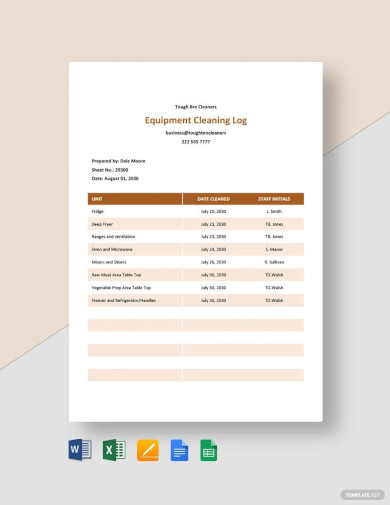
Free Equipment Cleaning Log Template
download now -
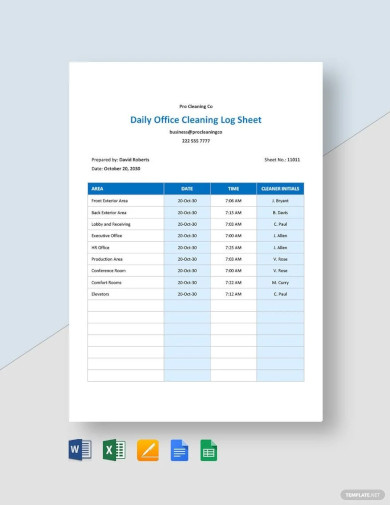
Daily Cleaning Log Template
download now -

Restroom Cleaning Log Template
download now -
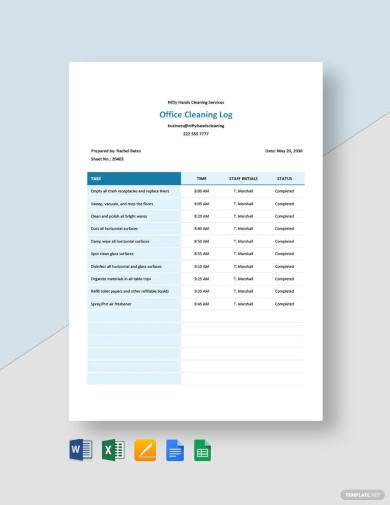
Office Cleaning Log Sheet Template
download now -
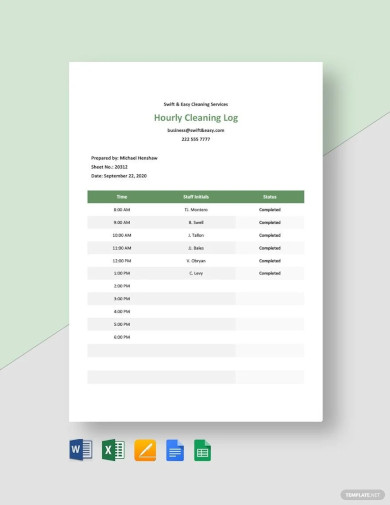
Hourly Cleaning Log Template
download now -
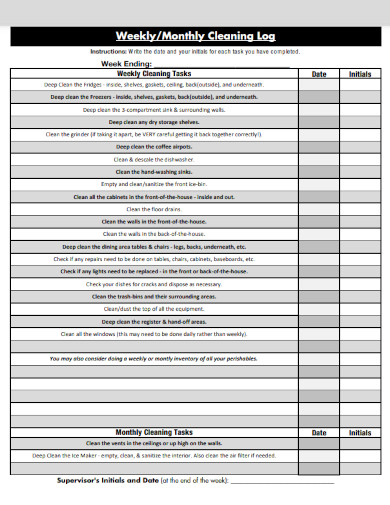
Sample Monthly Cleaning Log
download now -
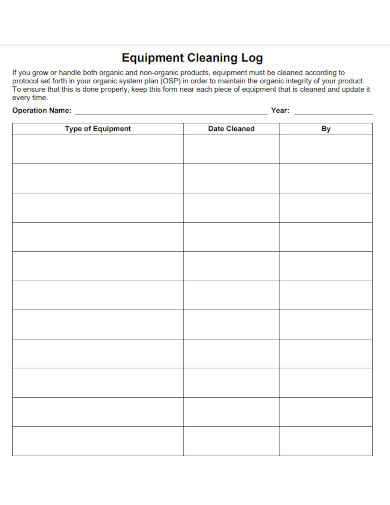
Sample Equipment Cleaning Log
download now -
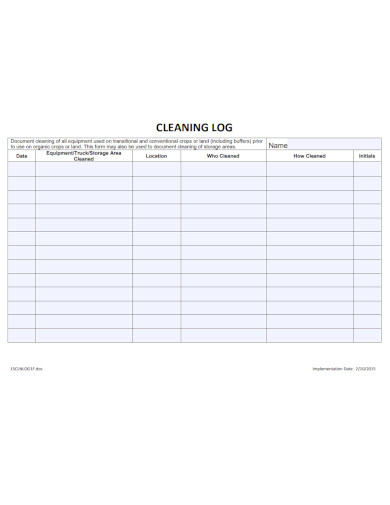
Sample Cleaning Log
download now -

Sample Maintenance Cleaning Log
download now -
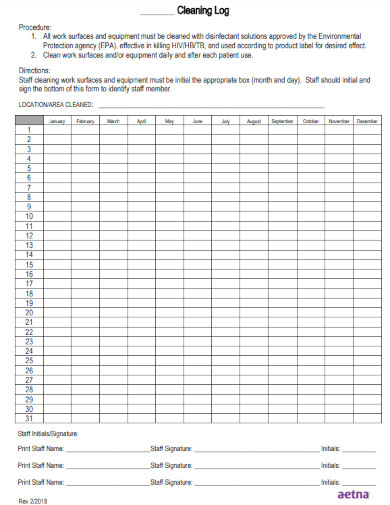
Sample Annual Cleaning Log
download now
FREE Cleaning Log s to Download
10+ Sample Cleaning Log
What is a Cleaning Log?
How does a Cleaning Log Benefit Businesses?
How Can I use a Cleaning Log to Improve Efficiency?
How can I Implement a Cleaning Log Effectively?
How often should a Cleaning Log be updated?
What information should be included in a Cleaning Log?
What is a Cleaning Log?
A cleaning log is a sample document record that systematically outlines the cleaning activities and tasks performed in a particular environment. Whether used in homes, businesses, or organizations, this log serves as a comprehensive tool to track and manage cleanliness. It typically includes details such as the areas cleaned, the specific tasks carried out, the date and time of cleaning, and the individuals responsible for the cleaning activities. A cleaning log is crucial for ensuring that cleaning efforts are consistent, thorough, and contribute to maintaining a hygienic and organized space.
You May Also See SAMPLE Food Log Spreadsheet
How does a Cleaning Log Benefit Businesses?
A Cleaning Log offers several benefits for businesses:
1. Compliance with Health and Safety Standards: Businesses are often subject to health and safety regulations. A well-maintained Cleaning Log helps demonstrate compliance with these standards, contributing to a safe and healthy environment for both employees and customers.
2. Prevention of Health Issues: Regular cleaning, documented in the Cleaning Log, helps prevent the spread of germs and contaminants. This is especially crucial in settings like restaurants, healthcare facilities, and offices where maintaining a clean and sanitary environment is paramount for the well-being of everyone involved.
3. Customer Impressions: A clean and well-maintained business space leaves a positive impression on customers. A Cleaning Log showcases the commitment to cleanliness, reinforcing the professionalism and quality of the business.
4. Efficient Resource Allocation: By tracking cleaning activities in the log, businesses can optimize resource allocation. This includes identifying peak cleaning times, ensuring the right cleaning products are stocked, and allocating staff effectively to maintain cleanliness without disrupting operations.
5. Documentation for Audits: In industries with strict regulatory requirements, a detailed Cleaning Log serves as valuable documentation during audits. It provides evidence of adherence to cleaning protocols and helps the business demonstrate its commitment to maintaining a clean and safe environment.
6. Employee Accountability: Assigning specific cleaning tasks to individuals in the log promotes a sense of responsibility and accountability among employees. This ensures that cleaning duties are carried out consistently and thoroughly.
7. Risk Management: Regularly updating the Cleaning Log allows businesses to identify and address potential issues promptly. Whether it’s a spill that needs immediate attention or a pattern of cleanliness concerns, the log serves as a proactive tool for risk management.
You May Also See SAMPLE Time Logs
How Can I use a Cleaning Log to Improve Efficiency?
1. Establish Clear Cleaning Protocols:
Define specific cleaning tasks for each area and establish a standardized cleaning protocol. Clearly outline the steps to be taken during each cleaning session.
2. Assign Responsibilities:
Clearly assign cleaning responsibilities to individuals or teams. In the Cleaning Log, mention who is responsible for specific tasks. This ensures accountability and a more organized approach.
3. Set a Regular Cleaning Schedule:
Establish a consistent cleaning schedule and adhere to it. The Cleaning Log should reflect regular and systematic cleaning routines, preventing the accumulation of dirt and ensuring continuous cleanliness.
4. Prioritize High-Traffic Areas:
Identify and prioritize areas that experience high traffic or require frequent cleaning. Focus on these areas in the Cleaning Log to address cleanliness needs efficiently.
5. Utilize Technology for Reminders:
Consider using digital tools or apps to set reminders for cleaning tasks. This helps ensure that cleaning activities are not overlooked and are conducted at the appropriate intervals.
6. Train and Empower Cleaning Staff:
Provide training on the use of the Cleaning Log and the established cleaning protocols. Empower cleaning staff with the knowledge and tools needed to perform their tasks efficiently.
7. Regularly Review and Update:
Periodically review the Cleaning Log to identify patterns, areas that may require additional attention, or tasks that can be optimized. Regular updates help maintain relevance and effectiveness.
8. Feedback and Continuous Improvement:
Encourage feedback from cleaning staff regarding the efficiency of the cleaning process. Use this input to make continuous improvements to the cleaning protocols and overall efficiency.
9. Optimize Resource Allocation:
Analyze the Cleaning Log data to optimize resource allocation. This includes ensuring that the right cleaning supplies are available, scheduling cleaning tasks during non-peak hours, and managing staffing levels effectively.
10. Integrate with Other Management Systems:
Integrate the Cleaning Log with other management systems if applicable. This could include connecting it with Business inventory management for cleaning supplies or employee scheduling systems for efficient staff deployment.
You May Also See SAMPLE Food Log Spreadsheet
How can I Implement a Cleaning Log Effectively?
Implementing a Cleaning Log effectively involves careful planning and consistent execution. Here’s a step-by-step guide to help you implement a Cleaning Log successfully:
1. Define Clear Objectives:
Clearly outline the objectives of the Cleaning Log. Whether it’s to meet regulatory requirements, enhance cleanliness, or improve organizational efficiency, having clear goals will guide the implementation process.
2. Select an Appropriate Format:
Choose a format that suits your needs. It could be a physical logbook, a digital spreadsheet, or a specialized cleaning management software. Ensure the chosen format aligns with your organization’s workflow and accessibility requirements.
3. Identify Cleaning Tasks:
List all the cleaning tasks that need to be performed in your environment. Be specific and detailed, covering everything from daily maintenance to periodic deep cleaning.
4. Establish Cleaning Frequencies:
Determine how often each cleaning task should be performed. Some tasks may be daily, while others may be weekly, monthly, or even seasonally. Clearly indicate these frequencies in the Cleaning Log.
5. Assign Responsibilities:
Clearly assign responsibilities for each cleaning task. Specify who is responsible for what, whether it’s an individual, a team, or external cleaning services. This promotes accountability and ensures that tasks are not overlooked.
6. Create a Schedule:
Develop a cleaning schedule based on the established frequencies and responsibilities. Ensure that the schedule aligns with operational needs and avoids disrupting critical activities.
7. Train Personnel:
Provide training to individuals responsible for cleaning tasks. Ensure they understand the Cleaning Log, the cleaning protocols, and the importance of maintaining accurate and up-to-date records.
8. Integrate into Routine:
Make the Cleaning Log an integral part of the daily routine. Encourage staff to refer to it regularly, update it after each cleaning session, and communicate any issues or deviations from the established protocols.
9. Regularly Review and Revise:
Schedule regular reviews of the Cleaning Log to identify areas for improvement. This could involve adjusting cleaning frequencies, refining tasks, or updating responsibilities based on feedback and evolving needs.
10. Use Technology Wisely:
If using digital tools, leverage technology for reminders, updates, and easy access. Ensure that the chosen technology aligns with your organization’s IT infrastructure and security policies.
11. Promote a Culture of Cleanliness:
Foster a culture of cleanliness within your organization. Encourage all team members to take ownership of their surroundings and understand how their contributions to cleanliness positively impact the overall environment.
12. Monitor and Evaluate:
Establish a monitoring system to track adherence to the Cleaning Log. Regularly evaluate its effectiveness in meeting your objectives and make adjustments as needed.
You May Also See SAMPLE Food Log Examples
How often should a Cleaning Log be updated?
Regular updates are essential. Depending on the environment, consider daily or weekly plan updates to reflect the latest cleaning activities and ensure accuracy.
What information should be included in a Cleaning Log?
Include details such as the areas cleaned, specific tasks performed, date and time of cleaning, and the individuals responsible. This provides a comprehensive overview of cleanliness efforts.
In conclusion, mastering the art of effective cleaning log creation is pivotal for maintaining a pristine environment. This guide has equipped you with the essential tips to craft a comprehensive and efficient cleaning log. From defining tasks to assigning responsibilities, integrating technology, and fostering a culture of cleanliness, follow these steps to elevate your cleaning routines and ensure a consistently spotless space.
